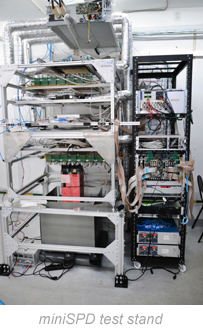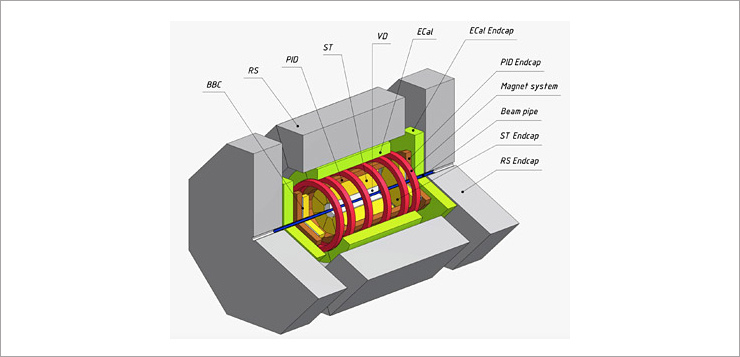SPD: first steps taken
Interview, 23 April 2021
The conceptual design of the SPD experiment (Spin Physics Detector), one of the key segments of the NICA mega-science project, was presented at the beginning of the year at the 54th meeting of the Programme Advisory Committee for Particle Physics. Head of the Scientific and Experimental Department of Colliding Beams of the Laboratory of Nuclear Problems A. V. Guskov who heads the SPD project spoke about the updated physical programme of the experiment and the concept of the experimental facility. The report was received with interest and enthusiasm. The editorial board of the JINR Weekly Newspaper asked Alexey Vyacheslavovich to answer some questions about the implementation of the SPD.
– The SPD collaboration is the youngest among the projects of the NICA accelerator complex. How many participants are there today? What famous institutes decided to participate?
– In fact, the collaboration is still in the process of establishment. The governing bodies and the technical council are being formed, and the constitution is being prepared for adoption. More than 200 scientists from 24 institutes of 11 countries signed the project, and the number of participants is increasing. Leading Russian scientific organizations, like ITEP, FIAN, PNPI, as well as universities and scientific centres of Italy, Poland, China, the Czech Republic, Cuba, Chile, Armenia, Belarus, Ukraine, and Serbia are active participants.
– What is SPD intended for?
– The SPD experimental facility, which is being planned to be placed in one of the two beam collision points of the NICA collider, aims at the comprehensive study of the spin structure of proton and deuteron. The main focus will be on the study of their polarized gluon component in reactions of inclusive production of charmonia, open charm, and prompt photons, as well as other spin-dependent phenomena in collisions of proton and deuteron beams with the centre-of-mass energy up to 27 GeV and luminosity of up to 1032 cm-2 s-1.
– What data is planned to be obtained at the facility?
– By measuring the corresponding spin asymmetries, it is planned to obtain data on the correlations between the directions of proton spin (deuteron), its momentum, as well as the spin direction, the longitudinal and transverse momenta of gluons inside the proton (deuteron). Functions describing such correlations are the same fundamental quantities for hadrons as their mass, charge, magnetic moment, form factor, etc.
At the first stage of the facility’s operation, before project luminosity and collision energy reached, scientists will pay most attention to the study of spin effects in elastic p-p and d-d scatterings, search for multiparton correlations, and new bound states, the study of the production of a charm at the threshold, hyperon polarization, etc.
– How does physical knowledge obtained at SPD fit into the scientific image of the world, what gaps will it fill?
– New data about the spin structure of proton and deuteron, which will be obtained at the SPD facility, will bring us closer to the understanding of the fundamental basics of quantum chromodynamics. It will possibly allow us to understand from the first principles the quark and gluon dynamics inside hadrons, which is nowadays one of the main unsolved QCD problems.
Research at SPD with the use of polarized proton beams will fill the kinematic range between low-energy measurements at the ANKE-COSY and SATURNE accelerators and high-energy measurements at the RHIC collider and planned experiments with the fixed target at the LHC. An opportunity to use polarized deuteron beams in this energy range is unique.
– Please, tell us about the detector’s structure. What systems will it consist of? What is their purpose?
– The experimental facility will have a geometric acceptance close to 4, an advanced track and vertex reconstruction system, as well as wide opportunities for particle identification based on modern technologies. The silicon vertex detector (VD) will provide resolution for the vertex position on the level of below 100 µm needed for reconstruction of secondary vertices of D-meson decays. The straw-tube based tracking system (ST)placed within a solenoidal magnetic field of up to 1 T at the detector axis will allow reconstructing the transverse pulses of secondary particles with an accuracy of up to 2 %. The time-of-flight system (PID) with a time resolution of 60 ps will ensure the separation of pions, kaons, and protons in a wide kinematic range. Possible use of the aerogel-based Cherenkov detector could extend this range. Detection of photons will be provided by the sampling electromagnetic calorimeter (ECal). To minimize multiple scattering and photon conversion effects for photons, the detector material will be kept to a minimum throughout the internal part of the detector The muon (range) system (RS) is planned for muon identification. It will also serve as a rough hadron calorimeter. A pair of beam-beam counters (BBC) and zero-degree calorimeters (ZDC) will be responsible for the local polarimetry and luminosity control. To minimize possible systematic effects, SPD will be equipped with a triggerless DAQ system. A high collision rate (up to 4 MHz) and a large number of detector channels pose a significant challenge to the DAQ, online monitoring, the computer post-processing system, and the software for data reconstruction and analysis.
– What is the fundamental difference between SPD and MPD?
– It should be noted that the SPD detector differs significantly from the MPD detector in its functionality. Each of the facilities is designed to solve its own set of scientific tasks, and they can fully replace each other. While MPD is designed for operation in conditions of a large multiplicity of secondary particles and under relatively low luminosity in heavy-ion collisions, then no multiplicity is expected at SPD operating with proton and deuteron beams. However, it is planned to achieve luminosity of several orders higher.
 – What is the way to advance the project before the experiments begin? What will be the next step?
– What is the way to advance the project before the experiments begin? What will be the next step?
– The next step in the implementation of the SPD project is an independent international assessment of the presented detector concept and the physical programme. Nowadays, a corresponding advisory committee is being formed, which will include world-known specialists in the fields of spin physics and related fields. Moreover, drafting of the technical design of the experimental facility is continued. There is a good groundwork for this: for most of the subsystems of the proposed facility, prototypes have been created and are being tested, which clearly demonstrate the possibility of achieving the required parameters. Some of the prototypes of detectors and subsystems are combined in the miniSPD test stand at which their parameters are studied, and their interaction with each other is optimized. As part of the preparation of the technical project, tests of the elements of the future facility will continue at Nuclotron extracted beams in the SPD test zone created specifically for this purpose.
– What can you say about the team working on the SPD project?
– Our team is qualified and balanced. The project involves specialists from four laboratories of the Institute: VBLHEP, DLNP, LIT, and BLTP. So, there are experimenters, theoreticians, and IT specialists among us. There are people who have extensive experience of participation in modern experiments on similar topics both at JINR and in world-leading laboratories, and there are young researchers who actively adopt their experience. We have specialists both in the development and creation of detectors, as well as in data modelling and analysis. We are actively attracting new personnel. Thus, just six months ago, after long work at foreign scientific centres, Alexander Yurievich Korzenev, who is now the technical coordinator of SPD, returned. As part of the programme of attracting outstanding young scientists to the Institute, Amaresh Datta joined our group experienced in analyzing data from polarized proton-proton collisions at the PHENIX experiment of the RHIC collider. During the preparation of diploma projects, university students are involved in the work. We complement each other. We learn from each other. We have a long and interesting road ahead of us.
Material prepared by Galina Myalkovskaya
JINR Weekly Newspaper
